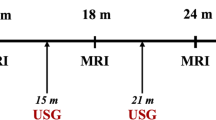Abstract
Purpose
To determine the frequency of locally recurrent Ewing sarcoma on surveillance MRI and the outcome of these patients.
Materials and methods
This retrospective single-center study included all patients with newly diagnosed Ewing sarcoma who underwent surveillance MRI of the primary tumor location after primary treatment between 1997 and 2016.
Results
Thirty-two patients underwent a total of 176 local surveillance MRI scans, yielding an average of 5.5 ± 4.4 MRI scans per patient. Follow-up time of surveillance MRI after completion of primary treatment ranged between 1 and 111 months. Surveillance MRI detected five (15.6%) locally recurrent Ewing sarcomas, at 2, 4, 6, 6, and 7 months after completion of primary treatment, of whom three also had simultaneous recurrent (metastatic) disease elsewhere. Two patients had recurrent metastatic disease without any signs of locally recurrent disease on surveillance MRI. All five patients with locally recurrent disease on surveillance MRI died, at 2, 4, 5, 8, and 9 months after local recurrence detection. Patients with locally recurrent disease had a significantly worse overall survival than patients without locally recurrent disease (log-rank test, P < 0.0001).
Conclusions
A limited number of patients have locally recurrent Ewing sarcoma on surveillance MRI. These patients often have simultaneous recurrent (metastatic) disease elsewhere, and their outcome is poor. Moreover, some patients present without locally recurrent disease on MRI but disease recurrence elsewhere. Therefore, surveillance MRI currently seems to have little value and should be reconsidered, also given the costs and the repeated exposure of surviving patients to gadolinium-based contrast agents.


Similar content being viewed by others
References
Gaspar N, Hawkins DS, Dirksen U, Lewis IJ, Ferrari S, Le Deley MC, et al. Ewing sarcoma: current management and future approaches through collaboration. J Clin Oncol. 2015;33(27):3036–46.
Esiashvili N, Goodman M, Marcus RB Jr. Changes in incidence and survival of Ewing sarcoma patients over the past 3 decades: surveillance epidemiology and end results data. J Pediatr Hematol Oncol. 2008;30(6):425–30.
Kauffman WM, Fletcher BD, Hanna SL, Meyer WH. MR imaging findings in recurrent primary osseous Ewing sarcoma. Magn Reson Imaging. 1994;12(8):1147–53.
Bacci G, Longhi A, Ferrari S, Mercuri M, Barbieri E, Bertoni F, et al. Pattern of relapse in 290 patients with nonmetastatic Ewing’s sarcoma family tumors treated at a single institution with adjuvant and neoadjuvant chemotherapy between 1972 and 1999. Eur J Surg Oncol. 2006;32(9):974–9.
Gulani V, Calamante F, Shellock FG, Kanal E, Reeder SB, International Society for Magnetic Resonance in M. Gadolinium deposition in the brain: summary of evidence and recommendations. Lancet Neurol. 2017;16(7):564–70.
Young DW. What does an MRI scan cost? Healthc Financ Manage. 2015;69(11):46–9.
Rossi Espagnet MC, Bernardi B, Pasquini L, Figa-Talamanca L, Toma P, Napolitano A. Signal intensity at unenhanced T1-weighted magnetic resonance in the globus pallidus and dentate nucleus after serial administrations of a macrocyclic gadolinium-based contrast agent in children. Pediatr Radiol. 2017;47(10):1345–52.
Tibussek D, Rademacher C, Caspers J, Turowski B, Schaper J, Antoch G, et al. Gadolinium brain deposition after macrocyclic gadolinium administration: a pediatric case-control study. Radiology. 2017;285(1):223–30.
Author information
Authors and Affiliations
Corresponding author
Ethics declarations
Conflict of interest
None (all authors).
Ethical approval
All procedures performed in studies involving human participants were in accordance with the ethical standards of the institutional and/or national research committee and with the 1964 Helsinki declaration and its later amendments or comparable ethical standards.
Informed consent
This study was approved by the local institutional review board and because of its retrospective nature the requirement for written informed consent was waived.
Rights and permissions
About this article
Cite this article
Kasalak, Ö., Dammann, A., Adams, H.J.A. et al. Surveillance MRI for the detection of locally recurrent Ewing sarcoma seems futile. Skeletal Radiol 47, 1517–1522 (2018). https://doi.org/10.1007/s00256-018-2966-9
Received:
Revised:
Accepted:
Published:
Issue Date:
DOI: https://doi.org/10.1007/s00256-018-2966-9




